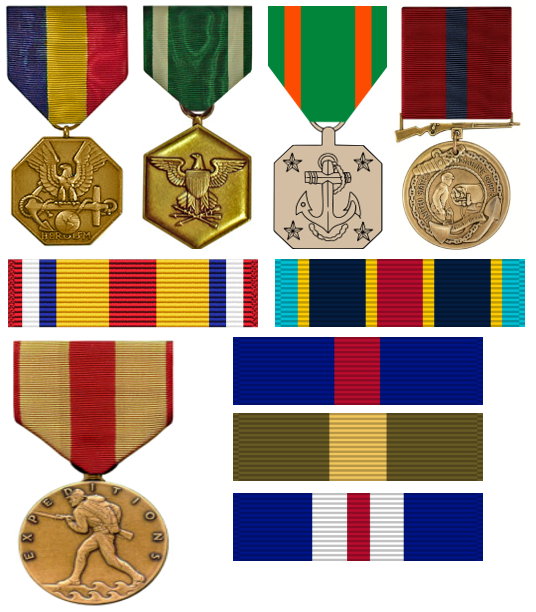Marine Corps awards and medals represent noteworthy achievements within the service branch.
As such, the Marine Corps presents a variety of service ribbons and medals to recipients.
These include important military distinctions like the Navy Cross, Commendation Medal, and Achievement Medal.
Learn more about the 10 most important Marine Corps medals, below.
Related Article – 12 US Marine Corps Ribbons Explained
Table of Contents
10 Marine Corps Medals Explained
The U.S. Armed Forces award medals and service ribbons for noteworthy accomplishments and merit.
As a result, the United States Marine Corps (USMC) is no different.
Marine Corps medals and ribbons are closely associated with the U.S. Navy and its awards.
As such, here are the top 10 Marine Corps medals based on the order of precedence on the military uniform:
- Navy Cross
- Distinguished Service Medal
- Navy / Marine Corps Medal
- Marine Corps Commendation Medal
- Marine Corps Achievement Medal
- USMC Joint Meritorious Award
- Marine Corps Good Conduct Medal
- Marine Corps Reserve Medal
- USMC Expeditionary Medal
- Marine Corps Overseas Medal
Marine Corps medals are distinguished by their appearance and the criteria to earn the award.
Learn more about each Marine Corps medal, below:
#1. Navy Cross
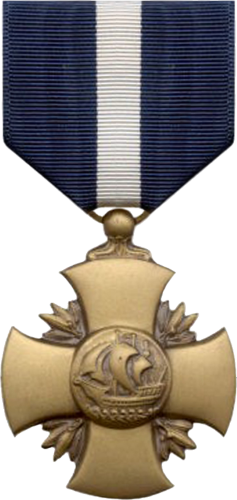
The Navy Cross is the second-highest military decoration in both the U.S. Navy and Marine Corps.
Accordingly, the military award is just a step down from the highest achievement — the Medal of Honor.
In general, the Navy Cross Medal is presented to individuals who have distinguished themselves by extraordinary heroism.
As such, both recipients of the Marine Corps and Navy are eligible to earn the distinction.
The Navy Cross is traditionally only awarded for acts performed in the presence of great danger or great personal risk.
For this reason, eligible recipients must fall under one of the following criteria:
- While engaged in an action against an enemy of the United States;
- While engaged in military operations involving conflict with an opposing foreign force; or
- In general, while serving with friendly foreign forces in an armed conflict against an opposing armed force in which the United States is not a belligerent party.
In the past, less than 6,500 recipients have earned this very selective military award.
Nonetheless, the number of award recipients has gone up slightly since the terrorist attacks on 9/11.
History
The Navy Cross is the equivalent of the Army Distinguished Service Cross, along with the Air Force and Coast Guard variations.
Interestingly enough, the Navy Cross has a history (established in 1919) that dates back to World War I.
Prior to that, the only award presented to service members was the Medal of Honor.
Today, the Navy Cross outranks the Distinguished Service Medal in order of precedence on the military uniform yet that was not always the case.
The Navy Cross is distinguished by a unique medal and service ribbon.
The design of the service medal depicts a sailing vessel with 4 laurel leaves extending from the middle.
Meanwhile, additional honors are noted on the service ribbon via gold or silver 5/16″ stars.
#2. USMC Distinguished Service Medal
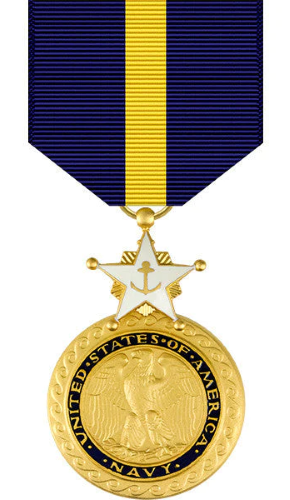
The Distinguished Service Medal (DSM) is another military award shared between the U.S. Navy and Marine Corps.
Often, the Marine Corps and Navy are unified in the same operations or military goals, making it necessary to also have crossover with its awards.
As such, the Distinguished Service Medal ranks just below the Navy Cross in order of precedence.
The Distinguished Service Medal is presented to service members who “display exceptionally meritorious service to the United States in a duty of great responsibility.”
In other words, the Marine Corps Distinguished Service Medal is generally only awarded to officers who have gone above normal expectations.
Generally, it may include a Marine Corps officer contributing to the success of a major command, operation, or military project.
The military award also has a long and decorated history dating to the same time period as the Navy Cross (World War I).
In fact, until 1942, the Distinguished Service Medal ranked above the Navy Cross in terms of importance.
Today, the Marine Corps Distinguished Service Medal continues to represent one of the highest honors of the service branch.
Additionally, the gold and dark blue appearance make it one of the most recognizable Marine Corps medals.
The medal depicts an American bald eagle surrounded by the lettering “For Distinguished Service MCMXVIII.”
Then, on the reverse side is a scroll that contains the name of the Marine to earn the military award.
Finally, the Marine Corps medal is suspended by a bar attached to the ribbon composed of scarlet, blue, and red.
#3. Navy and Marine Corps Medal
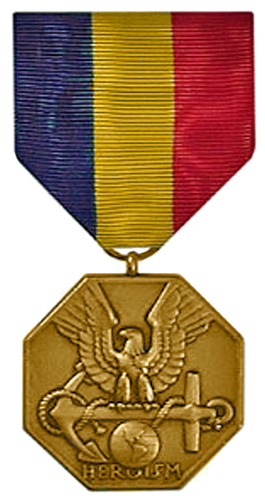
The U.S. Armed Forces awards medals for more than just combat situations.
As such, the Navy and Marine Corps Medal represents one of the highest achievements a service member can earn in these situations.
It’s the equivalent of the Army Soldier’s Medal, Airman’s Medal (Air Force and Space Force), and Coast Guard Medal.
The Marine Corps Medal was created in World War II to provide another military distinction for troops.
In general, the Marine Corps Medal is awarded to individuals not involved in direct conflict with the enemy.
The military branch assesses each situation differently yet generally takes into account the degree of “life-threatening risk.”
For this reason, the circumstances of each award recipient vary, yet the honor remains the same, regardless.
In the past, famous recipients of the Navy and Marine Corps Medal include President John F. Kennedy.
The Marine Corps Medal is distinguished by its bronze color and octagonal shape.
The medal depicts an eagle holding a fouled anchor over a globe with the word “Heroism” inscribed beneath it.
It’s accompanied by a service ribbon decorated in the color pattern of navy blue, old gold, and apple red.
#4. Marine Corps Commendation Medal
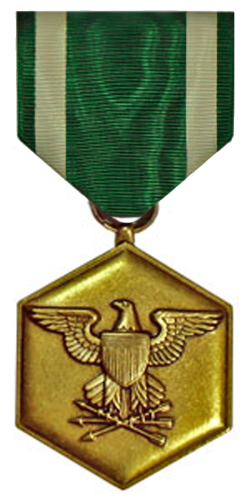
The Navy and Marine Corps Commendation Medal is an example of a “mid-level” military award.
It doesn’t rank quite as high as the top achievements like the Navy Cross and Distinguished Service Medal yet still represents heroic and meritorious service.
According to the criteria, eligible Marines must demonstrate one of the following characteristics:
- Acts of heroism that merit special recognition, but not to the degree of the Bronze Star Medal for combat or Marine Corps Medal for non-combat;
- Meritorious achievement that is outstanding and deserves to be recognized; or
- Meritorious service that is above and beyond what is usually expected of a Marine at a particular grade and rate.
The Commendation Medal is shared by every branch of the U.S. Armed Forces.
Additionally, a 5th version of the award exists and is presented by the Department of Defense (DoD) for joint military service.
The Commendation Medal has a long and decorated history with the Navy being the first branch to introduce the award (1943).
At first, the Commendation Medal was only awarded with a service ribbon and not an actual medal.
However, that has since changed along with the name of the award (Navy and Marine Corps Commendation Medal).
Furthermore, the U.S. Navy and Marine Corps (USMC) are generally more selective when handing out the award to eligible service members.
Be that as it may, it’s also not uncommon for the Navy and Marine Corps Commendation Medal to include various devices, including:
- “V” Device (for valor)
- Combat “V” Device “valorous actions in direct combat with the enemy)
- Combat “C” Device “valorous actions under the most arduous combat)
Lastly, silver or gold stars attached to the service ribbon designate additional awards.
#5. Marine Corps Achievement Medal
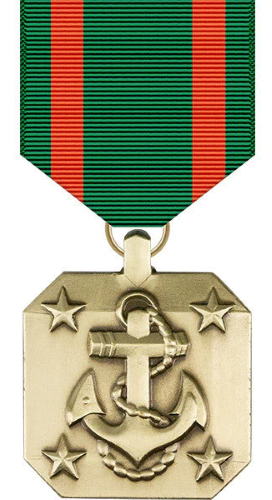
The Commendation Medal is another “mid-level” Marine Corps medal.
It’s a universal award that is shared by all branches of the Armed Forces, including a 5th version for joint service.
Additionally, members of the armed forces of a friendly foreign nation are also eligible for the military award.
The Marine Corps Commendation Medal is comparable to the Achievement Medal in terms of being awarded in non-combat situations.
And, like many Marine Corps medals, is also shared by members of the U.S. Navy and reserve components.
Thus, in order to receive the Navy and Marine Corps Achievement Medal, service members must demonstrate one of the following characteristics:
- Professional achievement that clearly exceeds the normal requirements and expectations given the individual’s grade and experience; or
- Leadership achievement that is noteworthy, sustained, or of such merit to earn singular recognition of the act(s), and reflect well on the individual’s effort to accomplish the unit mission.
In other words, recipients generally earn the military decoration for conduct that falls just short of the Commendation Medal or Marine Corps Medal.
Generally, local Marine commanders have broad discretion and authority for determining who and what conduct is eligible for the award.
The Achievement Medal was first created in 1961 by the U.S. Navy to recognize leadership and professional achievements.
Moreover, just like the Commendation Medal, it was originally just a service ribbon before the award expanded to include an actual medal.
Today, the appearance of the medal is noteworthy based on its bronze square with clipped corners design.
The medal depicts a fouled anchor in the center with stars in each of the 4 corners.
Meanwhile, the back of the medal is inscribed with the name of the Marine who earned the military award.
Related Article – 15 US Navy Ribbons Explained
#6. USMC Joint Meritorious Unit Award
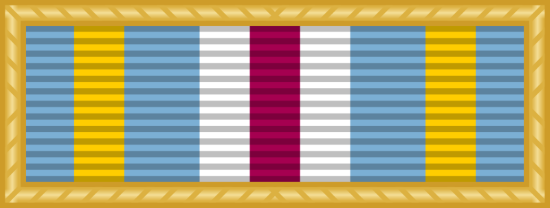
The United States Marine Corps (USMC) is closely associated with the Navy.
It operates under the command of the U.S. Navy and often assists with joint military activity.
As such, it’s not uncommon for Marines to be in the same unit as sailors and other military personnel.
For this reason, the Joint Meritorious Unit Award (JMUA) is frequently awarded to Marines for meritorious service in joint activities.
The Joint Meritorious Unit Award was established in 1981, but is retroactive to 1979.
It’s presented by the Secretary of Defense under the suggestion of the Department of Defense (DoD).
Accordingly, the military award traditionally is given to Marines for joint activities that are superior to that which is normally expected.
It may also include actions while engaged in combat with an armed enemy or during a declared national emergency.
Furthermore, the Joint Meritorious Unit Award is sometimes presented to service members who display courage and bravery under extraordinary circumstances involving national interests.
In the past, notable recipients included U.S. Marines and Navy personnel who served in Somalia during the early 1990s.
The Joint Meritorious Unit Award is doesn’t feature a medal, but rather a service ribbon only.
The service ribbon is enclosed with a gold frame and is often confused with the Defense Superior Service Medal.
Meanwhile, subsequent awards are designated by oak leaf clusters displayed directly on the military ribbon.
#7. Marine Corps Good Conduct Medal
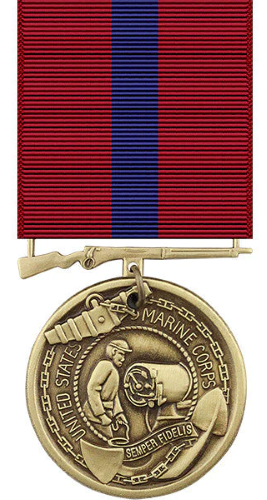
The Good Conduct Medal features an incredible history, unlike any other military decoration.
In fact, the Navy version of the award is one of the oldest in existence, dating back to 1869.
Meanwhile, it didn’t take long for the Marine Corps to follow along with its own variant produced in 1896.
As such, both the U.S. Navy and Marine Corps versions are 2 of the oldest military awards.
The awards preside over the Coast Guard, Army, and Air Force versions by several decades.
Therefore, many consider the Navy and Marine Corps Good Conduct Medal among the most prestigious.
Those that are eligible for the military achievement must demonstrate 3 consecutive years of “honorable and faithful service”.
Often, “honorable and faithful service” refers to a standard that falls above and beyond the minimum expectations of military service.
Thus, Marines with disciplinary infractions or court martial offenses are not eligible for the award.
Nevertheless, these same Marines may also become eligible after completing 3 years of “good conduct” service following the infraction.
Thus, it’s plausible for Marines to still earn the military decoration, or multiple awards, depending on length of service.
In the past, the length requirement has also been reduced to 1 year during times of war.
Moreover, the Good Conduct Medal is presented posthumously to qualifying enlisted personnel.
Appearance
Interestingly enough, the original medal offered in the late 19th century has changed little during its existence.
The only major difference is that the name of the recipient is no longer hand-engraved on the reverse side of the medal.
It’s been replaced by the words “Fidelity, Zeal, and Obedience” along with the removal of the clasp attached to the ribbon.
Otherwise, the Marine Corps medal has remained practically unchanged since its conception.
Additional awards are designated by 3/16″ silver and gold stars.
Silver stars are the equivalent of 5 bronze stars, with bronze stars representing another separate distinction.
#8. Marine Corps Reserve Medal
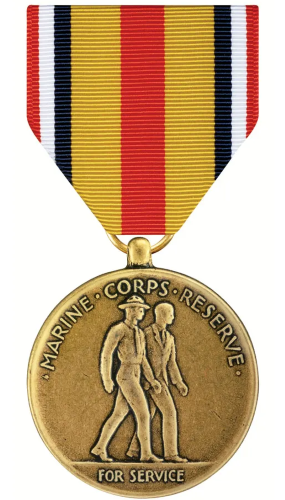
Unfortunately, the reserve components of the U.S. Armed Forces are sometimes an afterthought.
However, that is not the case with military decorations as certain awards are designated specifically for reserve personnel.
These include members of the U.S. Navy and Marine Corps Reserve.
In fact, the United States Marines was the first service branch to create an award specific to the reserve component in 1925.
It’s one of the few situations where the Marines version presided over the Navy medal for several decades.
The award was originally known as the “Fleet Marine Reserve Medal” yet was changed in 1939 to the “Organized Marine Corps Reserve Medal”.
Then, in 1984, it adopted its current name and appearance.
Moreover, in 1996, the Marine Corps changed the required 4 years of good conduct service to 3 years, like the Regular Corps version of the award.
Thus, additional awards are presented on the uniform much like other Marine Corps awards with bronze or silver stars.
Today, the Marine Corps variant remains in existence while the Navy eliminated its version in 2014.
It adopted a new award known as the Naval Reserve Meritorious Service Medal.
#9. Marine Corps Expeditionary Medal
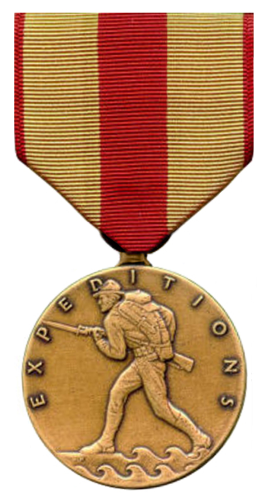
The Expeditionary Medal is another example of a military award with a long and fascinating history.
The Marine Corps variant was first introduced in 1919, then, as a ribbon (like many other awards on the list).
Then, a full-sized medal was authorized and added to the award a couple of years later in 1921.
Today, the Expeditionary Medal remains in existence and represents one of the oldest awards in the service branch.
In order to qualify for the Marine Corps Expeditionary Medal, service members must:
- Engaged in a landing on the foreign territory;
- Participated in combat operations against an opposing force; or
- Participated in a designated operation for which no other service medal is authorized.
Today, Marines may be assigned either the Marine Corps Expeditionary Medal or the Armed Forces Expeditionary Medal.
Often, it’s associated with providing “limited service” while engaged with an enemy force.
The medal was designed by Walker Hancock and is one of the most recognizable military awards.
It depicts a 1920s-era Marine in full combat gear advancing with one foot in the water and a foot on land.
The medal is designed to represent the amphibious nature of the Marines who must be skilled on land and in the water.
Meanwhile, on the reverse side of the Marine Corps Expeditionary Medal is an eagle alight upon an anchor.
The eagle is known to represent the United States while the anchor alludes to the Marine Corps.
Finally, the laurel on the medal is symbolic of victory and achievement in military service.
In the past, the Expeditionary Medal opted to designate multiple award winners with numerals displayed on the award.
Since then, however, multiple awards have been denoted by bronze service stars, like other Marine Corps awards.
#10. Marine Corps Overseas Medal

The Overseas Service Ribbon also ranks among the top Marine Corps medals in terms of importance.
It recognizes service members who have performed military tours outside the borders of the United States.
Therefore, recipients of the award include members of all branches of the Armed Forces.
Meanwhile, the U.S. Navy and Marine Corps combine their award into one primary distinction.
Thus, the appearance of the ribbon is identical to the Navy variant.
The Navy and Marine Corps Overseas Service Ribbon was first proposed in 1968.
However, it wasn’t until 1986 that the United States began to recognize this achievement in the military branches.
In general, eligible recipients must complete 1 year of consecutive or cumulative duty at a permanent overseas duty station.
Rather, inactive members of the reserve components may earn the distinction after completing 30 consecutive or 45 cumulative days of overseas duty.
Regardless, the criteria remain the same for active duty and reservists of the Marine Corps.
Since 1999, those stationed on overseas homeported naval vessels also qualify for the Navy and Marine Corps Overseas Service Ribbon.
Military personnel are authorized to wear the Overseas Service Ribbon along with the Sea Service Deployment Ribbon, if applicable.
Finally, additional awards of the Navy and Marine Corps Overseas Service Ribbon are denoted by service stars, like other awards.
Conclusion
It’s important to recognize the appearance and significance of military decorations.
These include medals and service ribbons that designate exceptional, courageous service.
Military achievements may occur during combat, or even in non-combat situations.
Thus, it’s important to recognize these awards along with proper placement and order on the uniform.
- Replacing Dog Tags: 6 Things You Need to Know - June 28, 2024
- Navy OAR Test Study Guide - June 24, 2024
- 10 Best Sniper Movies of all Time - June 20, 2024
Originally posted on June 14, 2023 @ 1:54 pm
Affiliate Disclosure: This post may contain affiliate links. If you click and purchase, I may receive a small commission at no extra cost to you. I only recommend products I have personally vetted. Learn more.
